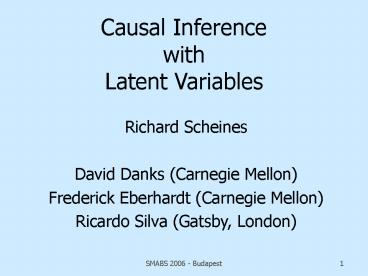Recent Advanced in Causal Modelling Using Directed Graphs PowerPoint PPT Presentation
1 / 20
Title: Recent Advanced in Causal Modelling Using Directed Graphs
1
Causal Inference with Latent Variables
Richard Scheines David Danks (Carnegie
Mellon) Frederick Eberhardt (Carnegie
Mellon) Ricardo Silva (Gatsby, London)
2
Graphical Models
- Non-parametric Representation of Causation
- X direct cause of Y relative to Z ---- X ?
Y - Intervention and manipulation represented
explicitly - Causal Inference
- From data and background knowledge -- find the
set of indistinguishable causal structures - Parametric Causal Models Structural Equation
Models, Bayes Networks
3
Representing Causal Systems Causal Graphs
- Causal Graph G V,E
- Each edge X ? Y represents a direct causal
claim - X is a direct cause of Y relative to V
Chicken Pox
4
Interventions Causal Graphs
- Model an ideal intervention by adding an
intervention variable outside the original
system as a direct cause of its target.
Intervene to treat Infection
Post-intervention graph
5
Causation Semantics vs. Epistemology
- Semantics what do we mean by X ? Y, or X Y
- Epistemology when do we know that X ? Y, or X
Y
6
Semantics of Causation
- Choice 1 Causal systems over V ? Probabilistic
Independence Relations in P(V) - Choice 2 Define X ? Y, or X Y in terms of
intervention, i.e., (hypothetical) treatment)
7
Choice 1 Causal Markov Axiom
- If G is a causal graph, and P a probability
distribution over the variables in G, then in P - every variable V is independent of its
non-effects, conditional on its immediate causes.
8
Choice 2 Define Causation from Manipulation
- X is a cause of Y iff
- ?x1 ? x2 P(Y X set x1) ? P(Y X set x2)
- Causation is asymmetric X Y ? Y X
X and Y are associated (X __ Y) iff ?x1 ? x2
P(Y X x1) ? P(Y X x2) Association is
symmetric X __ Y ? Y __ X
9
Choice 2 Define Direct Causation from
Intervention
- X is a direct cause of Y relative to S, iff
- ?z,x1 ? x2 P(Y X set x1 , Z set z)
- ? P(Y X set x2 , Z set z)
- where Z S - X,Y
10
Epistemology of Causal DiscoveryStatistical Data
? Causal Structure
11
Equivalence Classes
- Patterns No unmeasured confounders, no
feedback - Partial Ancestral Graphs (PAGs) unmeasured
confounders allowed - Psychometric Models
12
Patterns
13
PAGs Partial Ancestral Graph
14
Causal Epistemology
- Causal knowledge is
- Features of a causal structure shared by every
member of the equivalence class
- Examples
15
Three Problems for Causal Discovery with latents
- How can we use sequences of interventions
optimally when there might be latents? - How can we patch together knowledge from
disparate datasets that overlap? - How can we search over SEMs, in particular
- search for an appropriate measurement model, and
- search for the structural causal model
16
Experimental vs. Statistical Control
Does X1 directly influence X3?
Experimental Control
17
Searching for Causal SEMs
18
Latents and Measurement Models
Does Lead harm Cognitive Function?
19
Latents and Scales
ScalesLeadScale (X1 X2 X3 ) / 3
CogScale (X4 X5 X6) / 3HomeScale X7
X8 X9 ) / 3
Even without T, If rHome,HomeScale lt 1.0,
thenLeadScale __ CogScale HomeScale
20
References
- Causation, Prediction, and Search, 2nd Edition,
(2000), by P. Spirtes, C. Glymour, and R.
Scheines ( MIT Press) - Causality Models, Reasoning, and Inference,
(2000), Judea Pearl, Cambridge Univ. Press - Computation, Causation, Discovery (1999),
edited by C. Glymour and G. Cooper, MIT Press - Causality in Crisis?, (1997) V. McKim and S.
Turner (eds.), Univ. of Notre Dame Press. - TETRAD IV www.phil.cmu.edu/projects/tetrad

